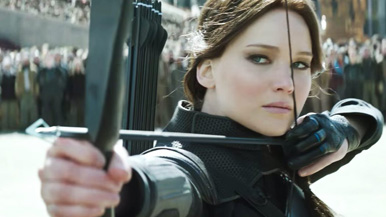Book vs. Movie - The Hunger Games: Mockingjay Part 2
By Ben Gruchow
November 28, 2016
Despite these changes, Mockingjay Part 2 is surpassingly loyal to the source material in both incident and tone, more so than any of the other films in the series, and it gets to hold the candle of being the only one of the Big Three YA adaptations (the other two being Harry Potter and Twilight) to present its climactic action, wind-down, and resolution mostly unaltered in both book and movie form.
The Verdict
The chief area where Catching Fire stumbled as a movie in comparison to the book was in its methodical chess-game nature and the evident build toward a larger plot working behind the scenes of the superficial action. With Part 1, I concluded that the movie was an improvement on the book, depending on how well its broader themes (which it more or less had to initiate from Square One, given the previous film’s lack of space for them) were resolved in this final installment.
Part 2 does address these themes, is a superior incarnation than its written counterpart, and corrects the shakiness of the denouement and resolutions to an extent that what was the weakest segment of the back half of the book becomes by far the strongest part of the film. And when the two films are put together, the cinematic Mockingjay achieves a fullness that is inherent to both parts but not apparent should they be seen separately. This occurred with the final Harry Potter installments, too. Director Francis Lawrence employs several bookending and mirroring techniques to stitch the two together; the ones that jump to mind immediately are the use of a cat coming through a kitchen window and triggering very different reactions, and the use of two rehearsed on-camera segments transforming unexpectedly into emotional appeals, one involving unstable rage and the other weary resignation.
He does something else, too: he and his filmmaking crew stress the routine of plumbing a revolution’s inner workings, and the cynicism that arises from it. This is particularly true of Part 1, but it finds its way in here - generally in the shortening pauses between violence as the movie winds its way toward the conclusion. Collins did this in her book too, but it was necessarily limited by Katniss’s point of view: we saw only as much as she saw, and she sees comparatively little.
The visual medium of film is going to almost by default present that cynicism in a more relevant way, and it’s one of the more significant factors in the difference between the book and movie. Back in 2001, Joss Whedon, of the first two Avengers films, was in the middle of production on Buffy the Vampire Slayer (arguably Ground Zero for serialized fiction centering around strong young women). In the middle of that show’s fifth season, he wrote and directed an episode entirely centering around a major character’s death. This episode was presented with virtually none of the common tropes that audiences associated with major deaths up to that point: no non-diagetic music, the presence of lengthy periods of silence, atypical camerawork. When Whedon was interviewed about that episode and what his rationale behind the presentation was, he said (paraphrased), “I wanted to show the boredom.”
There is an unfussy, straightforward nature to Lawrence’s work as a director in general that’s appealing; he is not known for utilizing slow motion, flashy camerawork, or other extravagant directorial flourishes. At the same time, he is very clearly a careful architect of his images; he prefers medium-focus and symmetrically balanced compositions, and he knows how long to hold a shot to allow the images the proper impact. He does not always present an artistic image, but he always presents discipline in the craft.
This has a noticeable impact on the latter three Hunger Games films; in their formal and observant way, they punch harder than the first film could hope to. This goes more so for this last film, which translates the strengths of the novel while somehow avoiding almost all of its weaknesses. It is not what I’d call a fun experience, and I wish that the trenchant political and social satire of the premise had a sharper presence in the film; then again, I wish the same of the source material. I find more to appreciate in the cinematic incarnation of this story, which is pervasively grim to the degree that its subject matter implies and insinuates that it should be, and far more emotionally accessible than its written counterpart.
Book vs. movie winner: Movie, by a considerable margin.
Continued:
1
2
3
4
5




